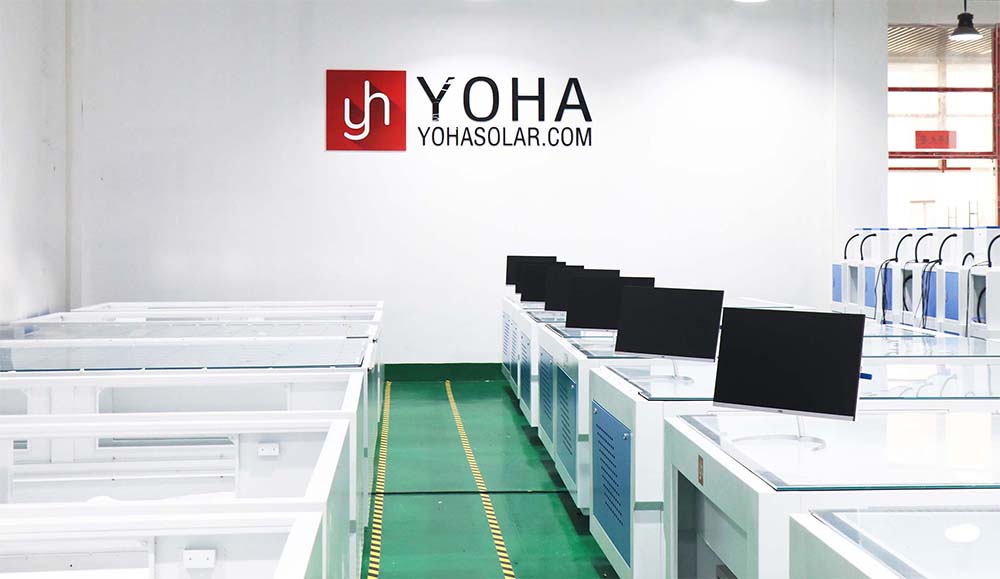In today's photovoltaic industry, striving for higher reliability and extended module lifespan, internal defects invisible to the naked eye – such as cell micro-cracks, finger interruptions, poor soldering, and sintering defects – act as lurking "hidden injuries," constantly threatening module power output and safety. PV module Electroluminescence (EL) testing is the precise technique that penetrates the barrier of encapsulation materials, actively "developing" internal defects. It functions like a pair of "X-ray eyes" for PV manufacturing, revealing the internal "optical fingerprint" of modules in a non-contact, non-destructive manner, serving as a core technological pillar for ensuring product quality and boosting power plant returns.
I. Electroluminescence: The "Language of Light" in Semiconductor Materials
The core principle of PV module EL testing is based on the optoelectronic conversion characteristics of semiconductor materials. When a forward bias voltage is applied to crystalline silicon (c-Si) solar cells, a unique physical reaction occurs internally:
- Carrier Injection: In a dark environment, a direct current (DC) close to the module's operating current (typically 80%-120% of Isc) is applied. This current injection forward-biases the cell's PN junction, prompting a large number of non-equilibrium carriers (electrons and holes) to overcome the potential barrier and enter the opposite regions.
- Radiative Recombination & Luminescence: The injected electrons and holes meet and recombine during diffusion. In indirect bandgap semiconductors like crystalline silicon, a portion of these recombinations releases energy by emitting near-infrared (NIR) photons (wavelength ~1100-1150 nm). This is the phenomenon of electroluminescence. The intensity of this luminescence is closely related to the injected current density and material quality.
- Defects as "Dark Spots": Areas within the module containing defects significantly alter carrier behavior, forming distinctive "dark spots" in the EL image:
- Current Blocking Zones (Micro-cracks, Finger Breaks): Physical cracks or interrupted gridlines hinder current flow, preventing carrier recombination in these areas, resulting in black lines or dark spots.
- Strong Recombination Centers (Poor Sintering, Impurities, Contamination): The presence of numerous defect energy levels promotes non-radiative recombination (energy released as heat instead of photons), causing weak luminescence (dark areas).
- Leakage Paths (Edge Shunting, Local Shorts): Abnormally low-resistance paths cause localized current crowding. Excessive carrier concentration leads to luminescence saturation or abnormally bright spots.
- Active Regions: Areas with intact material and good manufacturing processes exhibit effective carrier recombination luminescence, appearing as bright, uniform grey-white. PV EL testing deciphers the "health code" of modules precisely by capturing this distribution of light and dark patterns.

II. Core Technology: The Precision System for Capturing Weak Light Signals
Transforming electroluminescence into high-contrast images requires overcoming technological barriers in weak light detection and precise imaging. Modern PV EL test systems integrate multiple cutting-edge technologies from optics, mechanics, electronics, and computing:
- Precision Current Excitation System:
- High-Stability Programmable Power Supply: Delivers stable, precise, and fast-responsive forward current output, ensuring consistent and sufficient carrier injection for modules of various specifications.
- Multi-Channel Drive Technology: For large-format modules, employs zonal or multi-channel parallel drive to ensure uniform and rapid current injection, preventing image brightness inhomogeneity or smearing.
- Intelligent Safety Protection: Integrates multi-layer protection against over-current, over-voltage, and short circuits to prevent damage to valuable modules during testing.
- High-Sensitivity Near-Infrared Imaging System:
- Cooled IR Camera: The core is a CCD or sCMOS camera with extremely high quantum efficiency (QE) in the 1100-1200nm band. Deep cooling (e.g., -40°C) drastically suppresses thermal noise (dark current), enabling the capture of extremely weak (nW-level) NIR luminescence signals.
- High-Performance Optical Lens: Large aperture (low F-number) lenses collect more photons; low-distortion designs ensure edge-to-edge image clarity. For ultra-large modules, multi-camera stitching or high-precision scanning solutions are used.
- Efficient Narrow-Bandpass Filter: Precisely filters out ambient stray light (especially visible light), enabling high signal-to-noise ratio (SNR) images even in non-perfectly dark production line environments. The imaging quality of PV EL testing is the cornerstone of defect identification.
- Intelligent Image Processing & AI Diagnostics Engine:
- Image Enhancement Algorithms: Perform automatic background subtraction, flat-field correction, noise reduction, and contrast stretching to optimize image clarity and defect visibility.
- Deep Learning Defect Recognition (Key Advancement): AI models trained on vast annotated datasets (micro-cracks, finger breaks, poor soldering, cell fragments, black cores, sintering rings, fingerprints, etc.) can automatically:
- Locate: Precisely box defect positions.
- Classify: Identify defect types (e.g., distinguish linear cracks from net cracks).
- Quantify: Assess defect severity (e.g., calculate crack length, broken finger ratio).
- Automatic Grading: Outputs pass/fail or quality grade (A/B/C) conclusions based on preset standards (IEC or customer specifications). PV EL testing achieves an intelligent leap from "imaging" to "cognition."
III. Core Value: The Quality Guardian Across the Entire Value Chain
PV EL testing technology is deeply embedded in all segments of the PV industry chain, creating significant value:
- R&D Innovation: Evaluates the sensitivity to internal defects of new cell technologies (HJT/TOPCon/Perovskite), encapsulation materials (POE/EPE), and interconnection processes (shingled cells/0BB), providing critical input for reliability design.
- Production Quality Control (Core Application):
- 100% Inline Inspection: Performs non-destructive "health checks" on every module after lamination or at final inspection, efficiently intercepting products with critical defects like micro-cracks or finger breaks – a key barrier to improving yield.
- Process Optimization Loop: EL defect maps act as "developers" for process issues:
- Concentrated micro-cracks → Indicate mechanical stress issues in cell handling, stringing, or lamination.
- Patterned finger breaks → Point to screen printing or sintering process fluctuations.
- Poor soldering (bright/dark spots) → Require optimization of stringer temperature and pressure settings. PV EL testing drives continuous manufacturing process refinement.
- Power Plant Acceptance & O&M:
- Post-Installation Acceptance: Sampling or full inspection to verify if transportation or installation caused internal damage (e.g., newly formed cracks).
- Precise Fault Location: When power generation is abnormal, EL testing quickly locates:
- Cells corresponding to hot spots (often dark areas in EL images).
- Failed bypass diodes (corresponding sub-string doesn't luminesce).
- Potential Induced Degradation (PID) (large dark areas at module edges).
- Lifespan Assessment & Warranty: Compare historical EL images to quantify defect progression, assess remaining module lifespan, and support warranty claim decisions.
IV. Technological Frontiers: Clearer, Smarter, More Efficient
Facing challenges from higher efficiency, thinner wafers, and larger formats, PV EL testing technology is continuously evolving:
- Ultra-High Resolution Imaging: Adapts to detect ultra-fine gridlines (<20μm) and micro-cracks, meeting the demands of high-efficiency cells like HJT/TOPCon.
- Deep AI Integration:
- Few-Shot Learning: Improves recognition capability for novel or rare defects.
- Defect Prognostics: Predicts crack propagation risk and impact on power degradation based on image features.
- Multi-Modal Analysis: Fuses IV curve, thermal imaging, and EL data to build comprehensive fault diagnosis models.
- High Speed & Throughput: Optimizes excitation, imaging, and processing workflows, compressing single-module test time to under 5 seconds, matching GW-scale production capacity.
- Multi-Technology Fusion:
- Inline PL (Photoluminescence) Testing: Explored as a complement to EL (no power needed), particularly suitable for unencapsulated cell strings.
- IV+EL Integrated Test Stations: Enhance data correlation and testing efficiency.
- Adaptation to Novel Technologies:
- Optimize low-stress testing solutions for ultra-thin wafers (<100μm).
- Develop dedicated excitation and imaging modes for perovskite/tandem modules. PV EL testing continually expands its technological boundaries.
Conclusion: Light as the Scalpel, Revealing the Essence of Quality
PV module EL testing has evolved from a laboratory technique into a core pillar of modern PV smart manufacturing and power plant health management. With non-contact light, it illuminates every subtle "hidden injury" within the module; with intelligent diagnostics, it transforms abstract defects into quantifiable quality metrics; with data-driven insights, it fuels manufacturing optimization and precise plant O&M. As the PV industry advances towards the "Terawatt Era," smarter, more efficient, and more reliable PV EL testing technology will continue to serve as the indispensable "lens on quality," injecting robust assurance into the long-term, reliable operation of every module, safeguarding the bright future of clean energy.
keywords:
 Chinese
Chinese
 English
English
 Chinese
Chinese
 English
English

